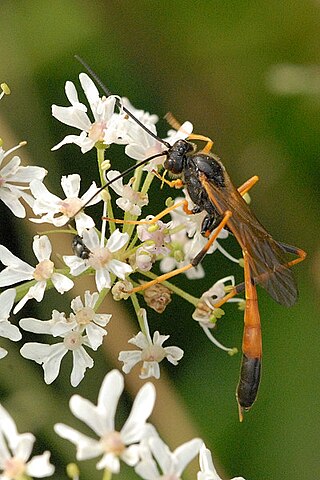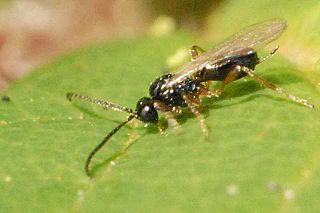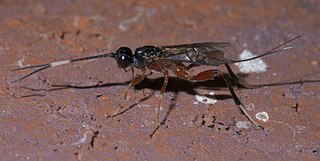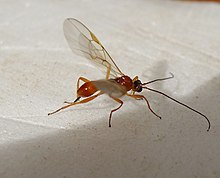
The Ichneumonidae, also known as ichneumon wasps, ichneumonid wasps, ichneumonids, or Darwin wasps, are a family of parasitoid wasps of the insect order Hymenoptera. They are one of the most diverse groups within the Hymenoptera with roughly 25,000 species described as of 2016. However, this likely represents less than a quarter of their true richness as reliable estimates are lacking, along with much of the most basic knowledge about their ecology, distribution, and evolution. It is estimated that there are more species in this family than there are species of birds and mammals combined. Ichneumonid wasps, with very few exceptions, attack the immature stages of holometabolous insects and spiders, eventually killing their hosts. They thus fulfill an important role as regulators of insect populations, both in natural and semi-natural systems, making them promising agents for biological control.

The Braconidae are a family of parasitoid wasps. After the closely related Ichneumonidae, braconids make up the second-largest family in the order Hymenoptera, with about 17,000 recognized species and many thousands more undescribed. One analysis estimated a total between 30,000 and 50,000, and another provided a narrower estimate between 42,000 and 43,000 species.

The Stephanidae, sometimes called crown wasps, are a family of parasitoid wasps. They are the only living members of the superfamily Stephanoidea. Stephanidae has at least 345 living species in 11 genera. The family is considered cosmopolitan in distribution, with the highest species concentrations in subtropical and moderate climate zones. Stephanidae also contain four extinct genera described from both compression fossils and inclusions in amber.

Anomaloninae is a subfamily of parasitoid wasps in the family Ichneumonidae. Several species provide beneficial services to humans by attacking forest or orchard pests.

Microgastrinae is a subfamily of braconid wasps, encompassing almost 3,000 described species, with an estimated 30,000–50,000 total species. This makes it one of the richest subfamilies with the most species of parasitoid wasps.

The Cheloninae are a cosmopolitan subfamily of braconid parasitoid wasps.

The Doryctinae or doryctine wasps are a large subfamily of braconid parasitic wasps (Braconidae). Numerous genera and species formerly unknown to science are being described every year. This subfamily is presumably part of a clade containing otherwise any or all of the Alysiinae, Braconinae, Gnamptodontinae, Opiinae and Ypsistocerinae, and might be most closely related to the last one of these. Whether the Rogadinae are also part of this group is not known.
Distatrix is a genus of parasitoid wasps in the family Braconidae. There are more than 30 described species in Distatrix, found throughout most of the world.

Meteorus is a genus of parasitoid wasps in the family Braconidae. It comprises over 330 species worldwide.

Dinotrema is a genus of wasps in the family Braconidae. Species are amongst the largest parasitoid wasps in the tribe Alysiini (Alysiinae). There are approximately 350 species described around worldwide.

The Alysiinae are a subfamily of braconid parasitoid wasps with over 1000 described species. Several species have been used in biocontrol programs. They are closely related to the Opiinae.

The Rogadinae are a large subfamily of braconid parasitoid wasps. Several Rogadinae species parasitize pest caterpillars and are important for naturally occurring biological control.
Hybrizon is the genus in the subfamily Hybrizontinae of ichneumonid parasitoid wasps. The subfamily was previously called Paxylommatinae, and has in the past been considered part Braconidae, or a separate family altogether.
Syntretus is a genus of parasitic wasps of adult bumblebees.

Blacini is a tribe of braconid Parasitoid wasps. Formerly the subfamily Blacinae, this group was demoted to a tribe and placed within the Brachistinae based on molecular evidence in 2011.

Brachistinae is a subfamily of braconid wasps in the family Braconidae.

Helconinae is a subfamily of braconid wasps in the family Braconidae. This is a large subfamily with many changes to classification and included groups over the years. There are about 40 genera worldwide in this subfamily.
Choeras is a genus of braconid wasps in the family Braconidae. There are at least 80 described species in Choeras, found worldwide.
Sathon is a genus of braconid wasps in the family Braconidae. There are more than 20 described species in Sathon, found throughout the world.
Hormius is a genus of parasitoid wasp in the subfamily Hormiinae first described by Christian Gottfried Daniel Nees von Esenbeck in 1818.















